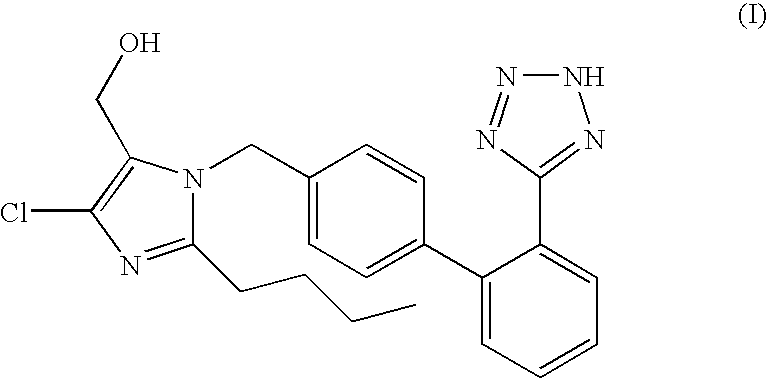Processes for preparing losartan and losartan potassium
a technology of losartan and losartan potassium, which is applied in the field of process for preparing losartan, can solve the problems of poor oral bioavailability and waning interest in peptide analogs, and achieve the effects of convenient recovery, high yield and high purity
- Summary
- Abstract
- Description
- Claims
- Application Information
AI Technical Summary
Benefits of technology
Problems solved by technology
Method used
Image
Examples
example 1
Preparation of Losartan
[0061]Aqueous hydrochloric acid (3 N, 39.1 mL, 117.3 mmol, 3 eq.) was added to a suspension of trityl losartan (26.0 g, 39.1 mmol) in acetone (150 mL) at room temperature. The reaction mixture was stirred for about 5 hours.
[0062]A solution of potassium hydroxide (85%, 11.0 g, 195.5 mmol, 5 eq.) in water (100 mL) was slowly added and acetone was evaporated under reduced pressure. A slightly yellow precipitate was filtered, washed with water (2×20 mL), and dried under reduced pressure (about 10 mmHg) at about 50° C. Triphenyl methanol (10.1 g, 99% yield) was recovered in 94.6% purity as determined by HPLC.
[0063]Ethyl acetate (100 mL) was added to the aqueous filtrate and the biphasic mixture was vigorously stirred and acidified to pH 3.5–3.6 by slow addition of 3N hydrochloric acid (about 25 mL). The resulting suspension was stirred for an additional 30 minutes and filtered. The wet cake was washed with ethyl acetate (50 mL) and an acetone / water (50:50, 50 mL) m...
example 2
Preparation of Losartan
[0064]A 100 liter reactor was charged with water (7.4 kg), 66% aqueous sulfuric acid (2.235 kg), acetone (23.75 kg) and trityl losartan (5.0 kg). The mixture was stirred for 4 h and 20 min. at 25° C. A solution of potassium hydroxide (2.7 kg) in water (28.5 kg) was added to the stirred mixture over 30 minutes which raised the pH of the mixture to 13.3. The temperature of the mixture was maintained between 18 and 23° C. over the course of the addition. The mixture was stirred for 16 h at 20–25° C. and then concentrated to 47.2 kg under reduced pressued pressure (200 mbar) at 30–32° C. Precipitated triphenylmethanol was filtered off and washed while on the filter with water (2×5.0 kg).
[0065]The combined filtrate and rinsate were washed with ethyl acetate (13.5 kg) at 25° C. and the organic layer was separated. Fresh ethyl acetate (9.258 kg) was added to the aqueous layer and the two-phase mixture was acidified from pH 9.28 to 3.44 at 25° C. with 66% aqueous sulf...
example 3
Preparation of Losartan Potassium
[0066]A solution of potassium hydroxide (0.305 g, 4.62 mmol (1 eq.)) and isopropyl alcohol (15 mL) was slowly added to a suspension of losartan (2.0 g, 4.73 mmol) in isopropyl alcohol (25 mL). The reaction mixture was stirred for about 2 hours at room temperature. The mixture was filtered, concentrated to about a 15 mL volume, heated to reflux and stirred for about 12 hours at room temperature. The precipitate was filtered, washed with isopropyl alcohol (5 mL), and dried under reduced pressure for about 2 hours at about 50° C. to give losartan potassium (1.85 g, 85% yield) as a white powder. Purity was determined to be 99.74% by HPLC. Losartan potassium (1.0 g) was then triturated with ethyl acetate (10 mL) and recovered from the triturate in a purity of 99.775% by HPLC.
PUM
| Property | Measurement | Unit |
|---|---|---|
| temperature | aaaaa | aaaaa |
| temperature | aaaaa | aaaaa |
| pH | aaaaa | aaaaa |
Abstract
Description
Claims
Application Information
 Login to View More
Login to View More - R&D
- Intellectual Property
- Life Sciences
- Materials
- Tech Scout
- Unparalleled Data Quality
- Higher Quality Content
- 60% Fewer Hallucinations
Browse by: Latest US Patents, China's latest patents, Technical Efficacy Thesaurus, Application Domain, Technology Topic, Popular Technical Reports.
© 2025 PatSnap. All rights reserved.Legal|Privacy policy|Modern Slavery Act Transparency Statement|Sitemap|About US| Contact US: help@patsnap.com



